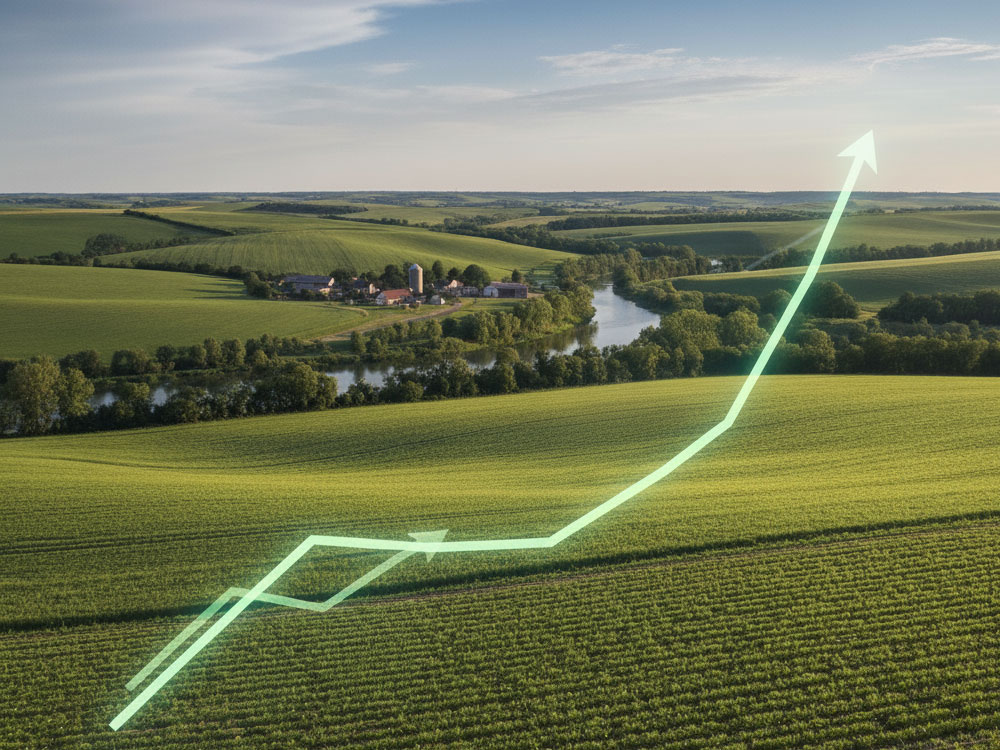Agricultural land does appreciate over time, but not in a straight line. Annual movements depend on land quality, location, buyer mix and policy. Below is a clear, UK-focused view with simple GBP examples you can use to benchmark your own holding – and if you wish to find out how you can increase your land value further, click here.
Is agricultural land increasing in value?
Over time, agricultural land does increase in value compared year on year. The value of farmland reached near-record levels through 2023 and remained at historically high levels during 2024. However, so far in 2025 we have seen a softer first half in some segments. Savills places the overall GB average agricultural land value come in at about £8,200 per acre halfway through the year, marginally lower than late 2024.
Strutt & Parker’s Rural Hub dataset for England shows 2024 arable averaging roughly £11,100 per acre and pasture near £9,000 per acre, with wide local variation. Two thirds of arable sales still clear £10,000 per acre or more.
Context matters. Farm profitability and commodity volatility whipsawed in 2023, then partially rebounded in 2024, which feeds into sentiment and bidding.
Annual examples in GBP
Use these to translate percentage moves into money you can recognise.
- England prime arable: Average price in 2024 about £11,100 per acre. Strutt & Parker report early-2025 averages closer to £10,400 per acre in some samples. On a 150 acre block, a shift from £11,100 to £10,400 equates to about £105,000 annual difference.
- Pasture land: Typical 2024 average around £9,000 per acre. A one percent dip in 2025 would be £90 per acre, so a 60 acre parcel would vary by about £5,400 against last year’s benchmark.
- Whole-farm basket: Savills’ overall GB average eased about one percent in H1 2025 to roughly £8,200 per acre. A 200 acre mixed farm valued at that level would move by about £16,000 for a one percent change, which is often outweighed by site-specifics like access, water and tenure.
Remember, ranges of agricultural land value are wide. Strutt & Parker recorded arable deals from roughly £6,500 to £17,000 per acre in 2024. Based on this, the take out is that the quality of the land and the location will have an effect on annual value increases.
What pushes farmland value up or down each year?
Market drivers include interest rates, buyer mix and supply. In 2024 almost 100,000 acres were marketed publicly in England, one of the highest totals in a decade, which naturally influences price formation.
On-farm economics also matter. UK Total Income from Farming rose in 2024 after a difficult 2023, yet the rebound was uneven by sector, so local appetite can diverge.
Policy and environmental markets add a new layer. Biodiversity Net Gain, natural capital and grid or energy leases can introduce alternative income streams, which some buyers capitalise into higher bids for suitable land. Live agent datasets and local comps remain essential to see what the market actually pays.
Does agricultural land go up in value?
Yes, agricultural land does go up in value, when recorded over multiple years. For example, if we look at the years 2019 to 2024 most indices show firm gains, followed by a period of consolidation into 2025. Even where headline averages pause, best-in-class parcels often hold their ground. The key is how your specific acres score on grade, access, water, scale, tenure and diversification potential.
Owner checklist to estimate your annual change
- Identify land type and grade, and any tenure or overage constraints.
- Pull the right comparable, for example arable and pasture benchmarks above, then localise by district – for more help, here’s how to value agricultural land.
- Adjust for abnormals such as poor access, wet ground, power capacity or major drainage works.
- Add or subtract for alternative revenue stacking potential including biodiversity units, nutrient solutions and energy or grid opportunities.
Where averages end and acceleration begins
Background appreciation is only part of the story. Annual agricultural land value inflects when you de-risk and diversify a holding. Examples include access and water solutions that open higher value uses, biodiversity strategies that monetise habitat creation, intensification of farmsteads, and energy or grid options that create long, bankable income. These levers can outperform the index when planned together with a clear route to delivery.
Intelligent Land’s Land Value Accelerator™ (LVA Method™)
Intelligent Land combines proprietary AI with 30 years of planning expertise to unlock hidden millions in land value. The LVA Method follows three steps. First, Review Planning Permissions to clarify your true baseline and constraints. Second, Undertake Research across technical, legal, BNG and ESG to surface risks and opportunities early. Third, Scenario Testing with AI to model layouts, access, utilities and environmental overlays and select the most valuable, deliverable path. Rapid scenario testing has identified £1m plus uplift within days in many cases. Explore case studies at Intel-land.com and see how the LVA Method converts uncertainty into value.
Intelligent Land. The explore engine for your land’s hidden potential. Unlock hidden millions today with us – here’s how we can help.




